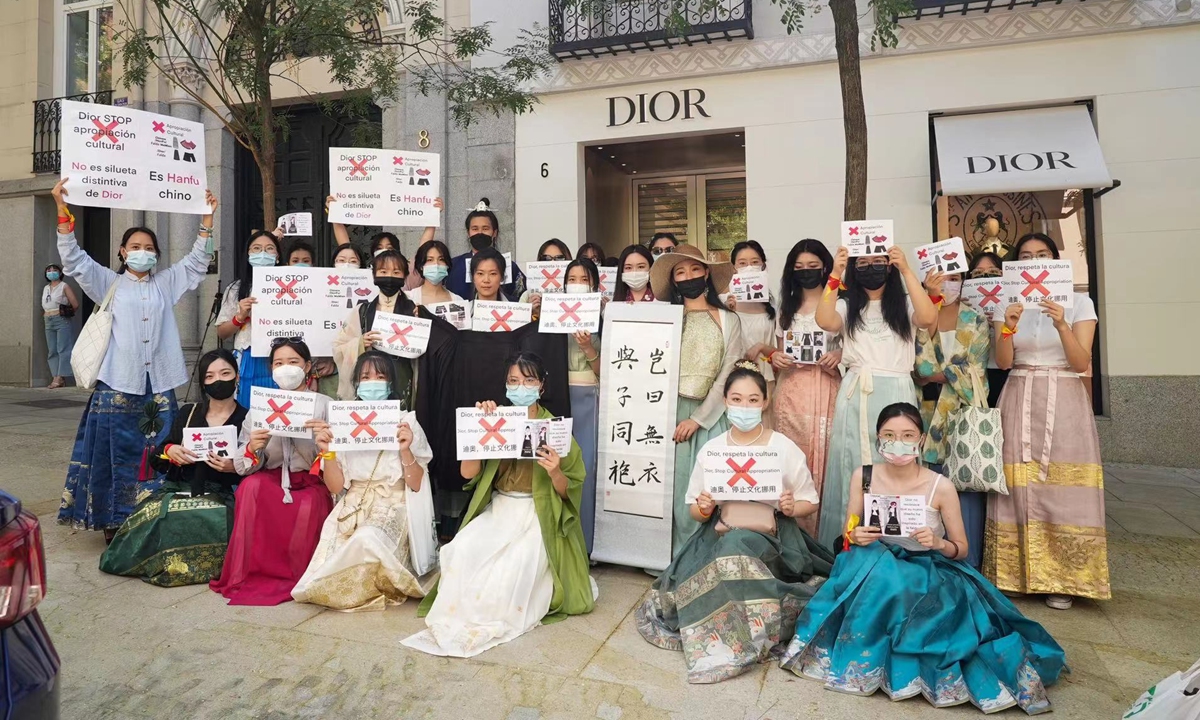
Protests have continued as many Chinese people who study or work in Madrid, Spain gathered outside a Dior store on July 30, 2022, to ask for its response to the issue after the brand was accused of copying the design of the traditional Chinese horse face skirt in its fall 2022 collection without clarifying its source of inspiration. Photo:courtesy of Zhuzhu (pseudonym)
Many Chinese nationals living overseas are holding protests against French fashion giant Dior in many countries, including Spain, France and the US, after the brand was accused of copying the design of the traditional Chinese horse face skirt in its fall 2022 collection without clarifying its source of inspiration, and refused to address the issue after more than a week.
After many Chinese raged against the brand in Paris, France on July 23, protests have continued as many Chinese people who study or work in Madrid, Spain gathered outside a Dior store on Saturday to ask for its response to the issue.
According to the organizers, similar protests will take place in Barcelona, Spain, New York, US, and Kuala Lumpur, Malaysia in the next few days.
While protests from Chinese are popping up in Dior stores in many countries, the fashion house doesn't appear to be giving any indication of a clear response to the matter. As of press time, Dior has not given a specific response to many Chinese media outlets, including the Global Times, other than "thank you for your attention."
However, the controversial skirt was no longer listed on Dior's website in many countries on Sunday afternoon, the Global Times has found, which has also been confirmed by many other netizens.
After only five days of preparation, more than 30 fans of Hanfu, a traditional Chinese garment, protested in front of Dior's store with over 600 leaflets and posters, the Global Times learned from two of the protesters Zhuzhu (pseudonym) who lived in Barcelona for many years and Miao Jiujiu (pseudonym) who studied in a local college in Madrid.
The protesters said they just wanted Dior to admit that the inspiration for the skirt came from China's horse face skirt, rather than steal it from other countries' culture as its original design, Miao Jiujiu said.
"Chinese culture is open and inclusive. We welcome the reference of Chinese culture elements to let more people around the world know about it. But Dior has to say clearly where it is from," Zhuzhu said.
According to Miao Jiujiu and Zhuzhu, the two-hour protest went smoothly and peacefully. Although most ordinary people had no idea about Dior's 'cultural appropriation,' many curious passers-by showed great support for them after finding out what happened.
A South American woman working at a nearby coffee shop came by to tell the protesters that it isn't the first time Dior has been guilty of cultural appropriation and that she supported the activity, the protestors told the Global Times.
The owner of a restaurant in the street opposite Dior's store told the protesters they could rest in his restaurant if they felt tired or hot after learning the whole story behind the protest.
According to Madrid protesters, there will be protests in London and New York on Sunday, as well as another protest in Barcelona next Sunday, and a gathering activity is being planned in Malaysia.
Meanwhile, public outcry against Dior continues in China. Earlier on Tuesday, a Hanfu lover surnamed Bao was driven out of a Dior store in a shopping mall in Hangzhou of East China's Zhejiang Province. Bao posted the video clip of the incident on China's Twitter-like Sina Weibo, which drew criticism of the French luxury brand.
Bao, who was wearing a bright yellow horse face skirt, was taking photos and videos of herself in front of a mirror at the Dior store when a Dior staffer came to stop her twice and asked her to leave. Bao then took photos in front of Dior's logo outside the store and was then stopped by a shopping mall staffer.
"Many Hanfu lovers wouldn't be so angry if Dior had used the Hanfu element on its clothes and noted where it comes from, just as the brand's former chief designer John Galliano has used Chinese culture elements many times but was always clear about their original sources," Bao told the Global Times.
Zhang Yiwu, a professor at Peking University, pointed out that in recent years, Chinese people have become more protective and loving about their traditional culture.
"In the past, some international brands thought that adopting Chinese cultural elements promotes Chinese culture and should be appreciated by Chinese," he said, "But now young Chinese are very concerned about cultural appropriation and are unwilling to accept cultural arrogance from the West."
An anonymous intellectual property expert told the Global Times on Sunday that international fashion brands' use of traditional elements of a certain nationality in their product design is usually beyond the scope of use under the current copyright law, making it more difficult for rights to be defended.
In recent years, as Chinese folklore has gained international recognition, Chinese lawmakers and folk enthusiasts have begun to explore legislation on the protection of folk culture and art. If such a law is enacted, infringements involving elements of traditional art are expected to be better regulated, the insider said.




